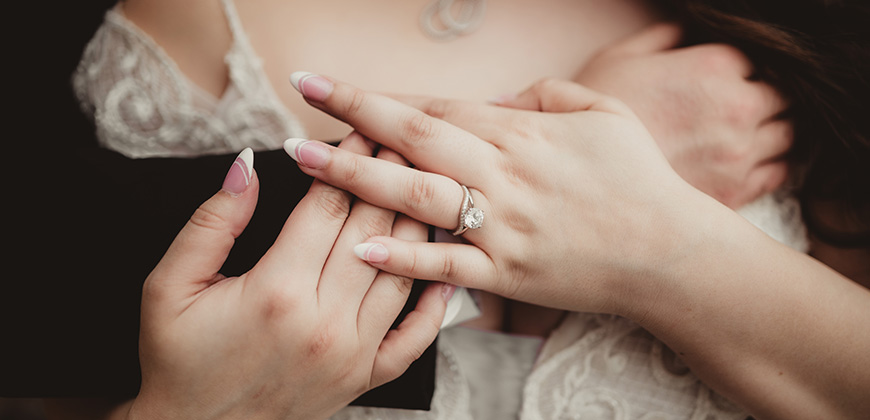
When it comes to diamonds, you’ve likely heard of an emerald cut. You’ve probably even heard of the princess cut, cushion cut, Asscher, marquise and round brilliant cuts. But have you ever heard of the shield diamond cut? While shield cut diamonds might not be the most common diamond cut around (which, unfortunately, means they are often hard to find), they are stunning and well-deserving of consideration if buying a uniquely shaped diamond ring is in your future. Read on to learn all about the shield diamond cut, its appeal and some world-famous shield cut diamonds.
What is a Shield Cut Diamond?
A shield cut diamond looks as you might suspect—like a shield. When viewed from the top, the shape resembles an old shield, often with a rounded top and sides that taper to a point. The shield cut combines the modern lines of a triangle with the soft appeal of curvy edges. Shield cut diamonds were first invented in the 16th century. They hit peak popularity in the Art Deco period of the 1920s and 1930s when geometric shapes and architectural influences dominated jewelry design. But its popularity has surged again in recent years, as interest in “vintage-meets-modern" increases in popularity. The shield cut is actually an incredibly rare diamond cut, making it a unique and sought-after choice.
Why Choose a Shield Cut Diamond Engagement Ring?
If you're still looking for that perfect reason to select a shield cut diamond engagement ring, here are five reasons to consider this unique cut.
That’s Just My Style
Sometimes, the only real reason you need to decide on a particular piece of jewelry is simply this: "I like what it looks like.” If it matches your personal style and just feels right, sometimes a gut instinct can tell you more than a gemstone grading report. The shield cut’s distinct, often edgy silhouette offers a bold and modern alternative to traditional shapes, making it perfect for those who want a statement piece. Unique and rare diamond cuts aren’t always the easiest to find, but if you’re lucky enough to get your hands on one, it is sure to stand out.
Be Honest; Does This Cut Make My Diamond Look Big?
It sure does! Sharp edges can make shield cut diamonds appear larger than their actual carat weight. This is great news in general, especially for shield cut diamonds, as larger shield cuts are rare, making them harder to find and notably more expensive.
A Vintage Art Deco Feel
Yes, several key diamond cuts are emblematic of the Art Deco era: emerald, Asscher and baguette. But of these, the shield cut diamond might be the rarest and most unique. The shield cut diamond, with its triangular shape featuring truncated corners, captures the bold symmetry that defined Art Deco design. The geometric angles and clean lines really bring that vintage aesthetic while still managing to look perfect in modern settings.
I Can See Clearly Now, the Inclusions Are Gone (or Hidden, at Least!)
If you're hoping for a diamond that expertly conceals natural flaws, the shield cut is an excellent choice. The shield cut excels at minimizing the appearance of inclusions in diamonds due to its strategic facet placement. This creates a brilliant play of light that can effectively mask minor imperfections, allowing even diamonds with slight inclusions to appear remarkably clear.
Rich Romantic Symbolism
Shield cut diamonds carry rich symbolism, particularly within romantic relationships. Their shape, reminiscent of a protective shield, naturally represents an enduring bond and a commitment to safeguarding the relationship. This symbolism extends to the idea of the relationship itself being a place of fortitude and safety, where partners cherish and protect one another.
Famous Shield Cut Diamonds
While every shield cut diamond is bound to dazzle and delight, here are a few famous shield cuts that have stood out over the years:
The Guinea Star Diamond
Discovered in Guinea (Western Africa) in 1986, the Guinea Star is an 89.01-carat, D-color, flawless diamond and is the largest shield cut diamond in existence. Its unique, modified shield-shaped cut combines brilliant and step-cut facets, making it a flattened, seven-sided gem. This rare diamond, known for its absolute colorlessness, was fashioned from a 255.10-carat rough diamond and is recognized as one of the most famous diamonds in the world.
The Moussaieff Red Diamond
The Moussaieff Red Diamond, found in Brazil, is a remarkable 5.11-carat, fancy red, internally flawless diamond and is the world’s largest red diamond (the rarest of all diamond coloring). Cut into a modified triangular brilliant, it's the largest of its kind. Purchased by Shlomo Moussaieff, an Israeli antiquities dealer and collector, in 2002 for around $8 million, it is estimated to be one of the most expensive diamonds in the world. Its deep red hue and exceptional clarity contribute to its significant value and fame.
The Sancy Diamond
The Sancy Diamond is a renowned historical gemstone tracing back to 14th-century India. This gem journeyed through the hands of numerous European monarchs, gaining a reputation for bringing good luck and bestowing powers of invincibility. The first documented appearance of the diamond in Europe was in 1389, when it weighed over 100 carats and had many owners before being purchased by King James I of England in 1604. The diamond was acquired by the Louvre Museum in 1978 for $1 million, where it remains today. Currently, the Sancy Diamond weighs 55.23 carats and is distinguished by its symmetrical facets, the absence of a pavilion, and two crowns positioned one atop the other.
Insure Your Diamond Ring with Jewelers Mutual
Your shield diamond ring deserves a little “protective shield” of its own. Consider insuring your shield diamond ring (or any diamond ring)—or any valuable jewelry, period! —with a personal jewelry insurance policy from Jewelers Mutual. It’s an affordable option that covers loss, damage and disappearance. You can check your rate online by clicking the button below.